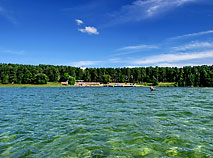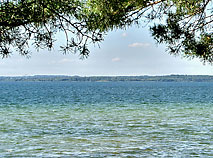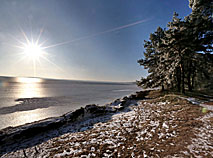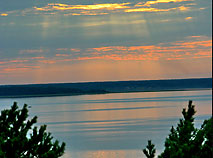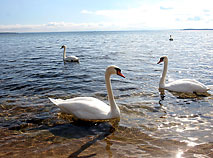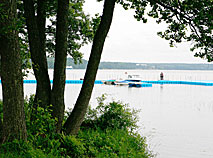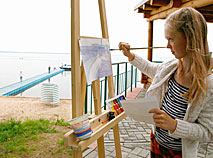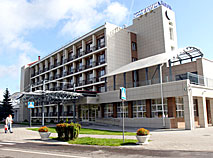National Park Narochansky
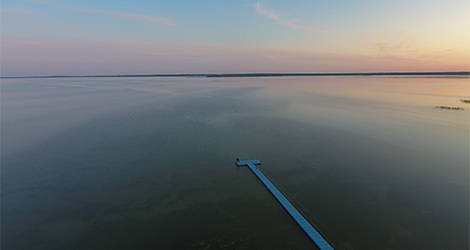
The Naroch Lake area is a unique natural treasure and the largest resort region of Belarus. Picturesque sceneries, clear lakes and rivers and healing mineral springs attract visitors from all over the world.
The national park Narochansky is located in the north-west of the country and is part of the Belarusian Lake District.
Naroch Lake region
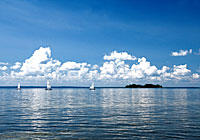 The Naroch Lake region is known for its natural diversity and a special landscape that was formed during the retreat of the Valdai glacier about 15,000-20,000 years ago. It was the time when famous Naroch lakes emerged.
The Naroch Lake region is known for its natural diversity and a special landscape that was formed during the retreat of the Valdai glacier about 15,000-20,000 years ago. It was the time when famous Naroch lakes emerged.
Reservoirs occupy about one-fifth of the park and represent basins of the Neman River and Western Dvina River. The rivers Stracha, Narochanka, Uzlyanka and Sviritsa are located there, too.
As many as 43 lakes are situated in the national park, including 4 groups: Naroch group, Myadel group, Bolduk group and Svir group. The gems of the region are the largest Belarus’ lake Naroch (79.6km2), Myastro and Batorino.
About 48% of the park is covered with pine and birch groves. Flora is marked by the variety of mosses, lichens, fungi and algae.
There are more than 1,400 species of higher plants, of which 114 are listed in the Red Book of Belarus, including Belarus’ most beautiful orchid - lady's slipper.
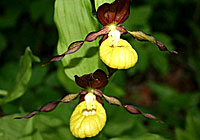 Fauna includes 314 species of vertebrates: European red deer, wild boar, elk, roe deer, raccoon dog, badger, marten, mink, otter, beaver, muskrat and others...
Fauna includes 314 species of vertebrates: European red deer, wild boar, elk, roe deer, raccoon dog, badger, marten, mink, otter, beaver, muskrat and others...
Due to the abundance of ponds and marshes this place is home to 218 species of birds. Over 51 of them are listed in the Red Book of Belarus: bittern, osprey and common crane...
About 35 species of fish inhabit Naroch’s lakes and rivers: pike, roach, perch, bream, crucian carp, silver bream and ruff…
History of the national park Narochansky
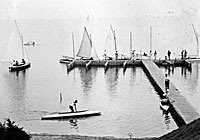 Since ancient times lands around Naroch Lake have attracted hunters, fishers, explorers and adventurers with the beauty and richness of nature, hunting and fishing.
Since ancient times lands around Naroch Lake have attracted hunters, fishers, explorers and adventurers with the beauty and richness of nature, hunting and fishing.
Private villas, a restaurant, a yacht club and a marina for sailing boats were built on the banks of the lake in the early 20th century. Suburban train service was available here.
In 1946, during the first scientific expedition mineral springs and therapeutic muds (sapropel) were discovered in the lakes Kuzmichi, Shvakshty and Dyagili. After this a balneotherapeutics resort was created here.
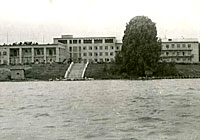 In the late 1950s active construction of tourist camps and holiday homes on the Naroch coast began. The sanatorium Naroch opened in 1963. Later the holiday house Naroch and the children's recreation camp Zubrenok were built...
In the late 1950s active construction of tourist camps and holiday homes on the Naroch coast began. The sanatorium Naroch opened in 1963. Later the holiday house Naroch and the children's recreation camp Zubrenok were built...
In the 1960-1970s the largest health resort area of the country appeared in the region.
The national park Narochansky was created in 1999 to preserve landscapes, biodiversity and the genetic fund of flora and fauna.
The national park Narochansky today
The territory of the park covers more than 87,000 hectares, and, apart from protected land (8.4%), includes a sanatorium and the economic zone. The park stretches 34km from north to south, and 59km from west to east.
The park includes 36 natural landmarks of national and local significance. Particularly valuable natural complexes are located here. These are reserves:
-
Blue Lakes (landscape complex)
-
Cheremshitsy and Shvakshty (hydrological complexes)
-
the Cherevki Peninsula (geological complex)
-
Nekasetsky, Rudakovo and Pasynski (biological complexes)
The largest health resort area of Belarus is located in the park. It unites 11 sanatoria and health centers. Today it is being actively modernized thanks to the implementation of the state program.
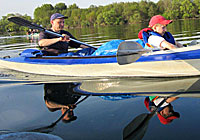 About 30 itineraries for tourists have been developed in the national park. Multi-day hiking, biking and water trips are organized, too. As many as 16 campsites are located on the shores of nine lakes.
About 30 itineraries for tourists have been developed in the national park. Multi-day hiking, biking and water trips are organized, too. As many as 16 campsites are located on the shores of nine lakes.
Moreover, helicopter trips are available in summer for those who want to enjoy bird's-eye view of the most beautiful places. Hunting and fishing tours, underwater fishing and diving are also organized in the park.
The most interesting eco-itineraries are:
-
Blue Lakes
-
the Cherevki Peninsula
Natural complex Blue Lakes
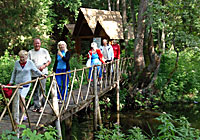 Blue Lakes is a unique natural hilly lake complex: its glacial terrain was formed thousands of years ago. Flora includes over 500 species of plants, of which about 30 are from the Red Book of Belarus. In 2005 the complex received the status of the key natural botanical territory.
Blue Lakes is a unique natural hilly lake complex: its glacial terrain was formed thousands of years ago. Flora includes over 500 species of plants, of which about 30 are from the Red Book of Belarus. In 2005 the complex received the status of the key natural botanical territory.
The Bolduk lake group, which includes more than 10 reservoirs, is of particular interest. Lake Bolduk is one of the deepest in Belarus (over 46m). Boltiksky spring, the second largest by power and size in Belarus, is also situated here.
Park of rare plants
The Park of Rare Plants is located on the territory of the geological natural monument Cherevki Peninsula, which includes over 10 rare species listed in the Red Book of Belarus and protected in Europe.
Dendrological garden
A dendrological garden named after S.A. Gomza was created on the banks of the lakes Naroch and Myastro in 2002. The garden features a surprising collection of about 400 species of trees, bushes, and herbs. It is also the place of the Forest Museum where visitors can observe the life of a tree at various stages.
How to get there and where to stay
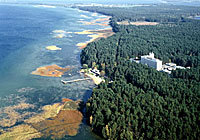 The national park Narochansky is located in Myadel District and Vileika District of Minsk Oblast, Postavy District of Vitebsk Oblast and Smorgon District of Grodno Oblast.
The national park Narochansky is located in Myadel District and Vileika District of Minsk Oblast, Postavy District of Vitebsk Oblast and Smorgon District of Grodno Oblast.
The administrative capital is the resort town of Naroch, Myadel District. It is 160km from Minsk, 280km from Vitebsk, and 350km from Grodno.
The easiest way to get there is by car after getting familiar with the map and choosing motorways in the direction of Myadel. Travelling from Minsk to Belarus’ largest lake will take about 2 hours (R58, R28 motorways).
Minsk’s central bus station offers bus service to the resort town of Naroch and to Myadel.
Tourists are invited to stay at the comfortable Naroch Hotel, the inn and cottages of the holiday camp Naroch (12km far from the town). Guests will be able to use services of:
-
Recreation camp Pronki
-
Hotel complex Shvakshty
-
Cottages for guests
-
Farm tourism estates
Places to see around Naroch Lake
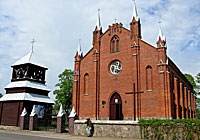 In the area there are specimens of Belarusian history and culture, including ten mounds, 20 hill forts and human settlements.
In the area there are specimens of Belarusian history and culture, including ten mounds, 20 hill forts and human settlements.
The Naroch Lake land is proud of its Christian relics and magnificent temples, ancient estates.
In the village of Naroch you will be able to see Ilya Church (19th century), St Apostle Andrew catholic church (early 20th century), which is famous for its organ (1902), a monument to John Paul II (2008).
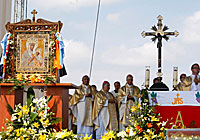 In the village of Budslav you will be able to see Belarus’ largest catholic temple — Madonna’s Assumption catholic church. In the church you will be able to see the Budslav Mother of God icon, which Minsk war chief Yan Pats received from Pope Clement III in 1598. In 1613 the icon was presented to the Budslav Bernardine monastery.
In the village of Budslav you will be able to see Belarus’ largest catholic temple — Madonna’s Assumption catholic church. In the church you will be able to see the Budslav Mother of God icon, which Minsk war chief Yan Pats received from Pope Clement III in 1598. In 1613 the icon was presented to the Budslav Bernardine monastery.
Celebrations in honor of the 400th anniversary of the icon’s acquisition gathered about 45,000 pilgrims from all over the world in 2013.
Other places of interest include:
-
St Trinity catholic church and ruins of the Carmelites monastery in the village of Zasvir
-
Blessed Virgin Mary Assumption catholic church in the village of Konstantinovo
-
St Nikolai catholic church in the town of Svir
-
Mother of God catholic church in the village of Shemetevo
-
Mother of God catholic church in Myadel
-
Myadel Calvaria
-
Hill fort of Myadel Castle
-
Estates in the villages of Komarovo, Olshevo, and Shemetovo


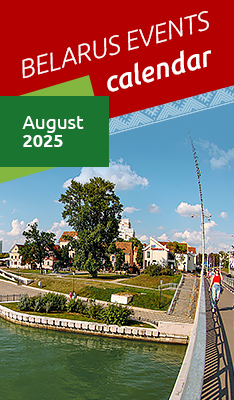




 print version
print version make home page
make home page add to bookmarks
add to bookmarks